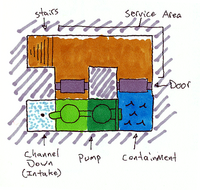- v50 information can now be added to pages in the main namespace. v0.47 information can still be found in the DF2014 namespace. See here for more details on the new versioning policy.
- Use this page to report any issues related to the migration.
Reservoir
| Part of a number of articles on |
| Projects |
|---|
| Basic |
| Aqueduct • Archery tower • Atom smasher • Danger room • Dam • Garbage dump • Mass pit • Moat • Pit trap • Reservoir• Sally port • Swimming pool • Tower • Tree farm |
| Advanced |
| Drowning chamber • Magma piston • Obsidian farm • Pump stack • Silk farm • Water reactor |
v50.12 · v0.47.05 This article is about the current version of DF.Note that some content may still need to be updated. |
A reservoir (or cistern) is a room constructed to contain water or magma whenever such storage is needed. At its simplest, a reservoir is simply a room that is mined out and then sealed (with a wall or floodgate), with water routed into it. Properly constructed, water in a reservoir should never freeze or evaporate, and will always stay fresh. Such a structure is useful in a variety of situations, and is an integral feature of most advanced fortresses.
Construction
Reservoirs are quite basic in construction, consisting of a dug out pit in the form of a container, connected to a water supply and then sealed off either with walls, a floodgate, or a bridge. The water supply is then opened, allowing the room to flood; how this water is supplied is a topic for the well guide.
Most wells are made to be refillable once their contents run low, usually through the use of levers attached to whatever is linking the source to the container (usually a floodgate and a body of water). They can be further refined to refill automatically through the use of pressure plates.
If there is a path from your reservoir into your fortress (ae. through a channeled hole or a well), it is additionally a good idea to be able to seal the reservoir when needed to protect against amphibious foes, who can and will path through your cistern and up your well to attack. If you are additionally worried about building destroyers, constructing a fortification and then being able to isolate it should solve the problem; fortifications let water (and any swimmers therein) of maximum height (7/7) through, but blocks all else.
Note that desalinated water that comes into contact with salt water will become salty, and fresh water that comes into contact with stagnant water will become stagnant, requiring all the water in the cistern to be pumped out for any attached well to be useful again.
Uses
Reservoirs are most commonly used to provide an internal well. Wells are an essential feature in any fortress; wounded dwarves require fresh water to drink and clean their wounds, and will die of dehydration if it is not provided or inaccessible (as often happens in a siege). However, they are very picky in terms of what they need: a proper well requires clean, flowing (not stagnant) water or else it will cause infections among your hospitalized dwarves.
Stagnant water must be cleaned and salt water (from an ocean or saltwater lake) must be desalinated: both tasks are performed by a screw pump, and the easiest way to keep the clean water contained is in a reservoir. This also applies to cold or freezing maps, where water may only be available part of the year (or never at all), and hot or scorching maps, where water may evaporate over time. A secured 20x25x1 underground reservoir can last for many years without needing to be refilled. (A reservoir for a well should be deeper, though, to prevent the water hauled up from being "laced with mud".)
Reservoirs are additionally useful for the construction and reliability of large traps, like drowning chambers, or passive water-using structures, like mist generators, on maps where the water supply freezes seasonally. In the former case, a special type of reservoir is an evaporation chamber, a large room into which water is dumped by gravity; the object is to get rid of a lot of water quickly so the trap can be reused.
Finally, reservoirs are essential for storing instant fun magma brought up by a pump stack. Since magma has almost no natural flow, a reservoir can be used to incur pressure in the magma so that it can be rapidly spit out in whatever application it is needed for, goblin-melting or otherwise.
